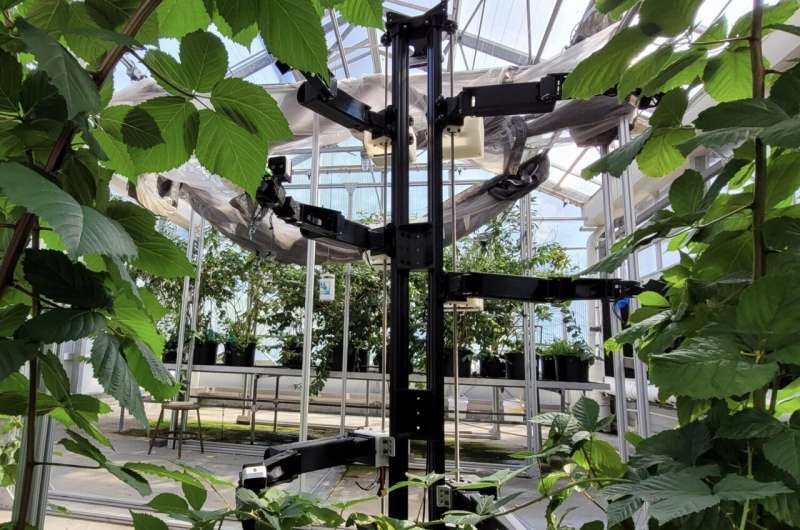April 29, 2024 feature
This article has been reviewed according to Science X's editorial process and policies. Editors have highlighted the following attributes while ensuring the content's credibility:
fact-checked
preprint
trusted source
proofread
A six-armed robot for precision pollination

Over the past decades, dozens of animal species have become extinct, while thousands of others are now at risk of disappearing. Endangered species include various pollinators, including bees and some types of moths, butterflies, and flies.
As pollination is an essential step for the growth of fruits, vegetables, and seeds, the extinction of these species could threaten food security worldwide. Some engineers have thus been trying to develop alternative pollination approaches that could be easily implemented in real-world environments.
A particularly promising approach entails the development of pollination robots, robotic systems that can autonomously disperse pollen in the air. Despite their potential for the pollination of some crops, many of these robots are unable to pollinate all types of flowers.
To overcome this limitation, researchers at West Virginia University have been working on so-called precision pollination robots, which are designed to employ carefully tailored strategies to transfer pollen to specific types of flowers. Their latest precision pollination system, a six-armed robot called Stickbug, was presented in a recent paper pre-published on arXiv.
"This work presents the design of Stickbug, a six-armed, multi-agent, precision pollination robot that combines the accuracy of single-agent systems with swarm parallelization in greenhouses," Trevor Smith, Madhav Rijal and their collaborators wrote in their paper.
"Precision pollination robots have often been proposed to offset the effects of a decreasing population of natural pollinators, but they frequently lack the required parallelization and scalability. Stickbug achieves this by allowing each arm and drive base to act as an individual agent, significantly reducing planning complexity."
Stickbug, the new precision pollination robot developed by Smith, Rijal and their colleagues, builds on a robotic platform they introduced a few years ago, called BrambleBee. While BrambleBee was found to successfully pollinate flowers in the bramble family, including blackberry and raspberry flowers, it only has a single manipulator, which limits its scalability and increases the time it requires to pollinate entire fields.
The team thus set out to develop a new pollination robot that had several arms and could thus pollinate more flowers at once. This ultimately led to the creation of Stickbug, a robot with six robotic manipulators that can tackle different pollination tasks independently
"Stickbug uses a compact holonomic Kiwi drive to navigate narrow greenhouse rows, a tall mast to support multiple manipulators and reach plant heights, a detection model and classifier to identify Bramble flowers, and a felt-tipped end-effector for contact-based pollination," Smith, Rijal and his collaborators wrote in their paper.
The researchers evaluated a prototype of their robot in a real-world experiment, placing it in front of an artificial bramble plant, as flowers were not blooming at the time of the experiment. The robot's mission was to pollinate as many flowers as possible within a 5-minute period.
"Initial experimental validation demonstrates that Stickbug can attempt over 1.5 pollinations per minute with a 50% success rate," Smith, Rijal and their colleagues wrote. "Additionally, a Bramble flower perception dataset was created and is publicly available alongside Stickbug's software and design files."
The new precision pollination robot developed by Smith, Rijal and their colleagues could soon be tested on real plants, to validate its feasibility. In the future, Stickbug could be perfected and introduced in real-world settings, particularly in environments where natural pollinators have declined and thus harvests are scarce.
"Future work will provide subsequent experiments on live plants during the flowering season and improve flower memory and re-identification through Intersection over Union (IoU) and flower relative graph-based mapping," the researchers wrote.
"Additionally, we plan to enhance manipulator capabilities by integrating a search function and flower load balancing, leveraging the referee to generate a global flower map to direct manipulators toward unexplored and flower-dense regions."
More information: Trevor Smith et al, Design of Stickbug: a Six-Armed Precision Pollination Robot, arXiv (2024). DOI: 10.48550/arxiv.2404.03489
© 2024 Science X Network


















